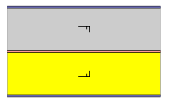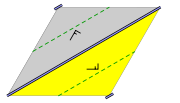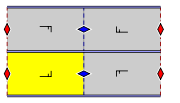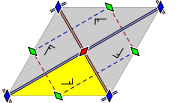
Line group
Encyclopedia
A line group is a mathematical way of describing symmetries
associated with moving along a line. These symmetries include repeating along that line, making that line a one-dimensional lattice. However, line groups may have more than one dimension, and they may involve those dimensions in its isometries
or symmetry transformations.
One constructs a line group by taking a point group
in the full dimensions of the space, and then adding translations or offsets along the line to each of the point group's elements, in the fashion of constructing a space group
. These offsets include the repeats, and a fraction of the repeat, one fraction for each element. For convenience, the fractions are scaled to the size of the repeat; they are thus within the line's unit cell segment.
Cn and Dn:
, which involve reflections along the line, reflections perpendicular to the line, and 180° rotations in the two dimensions.
. As with space groups in general, line groups with the same point group can have different patterns of offsets. Each of the families is based on a group of rotations around the axis with order n. The groups are listed in Hermann-Mauguin notation
, and for the point groups, Schönflies notation. There appears to be no comparable notation for the line groups. These groups can also be interpreted as patterns of wallpaper group
s wrapped around a cylinder n times and infinitely repeating along the cylinder's axis, much like the three-dimensional point groups and the frieze groups. A table of these groups:
The offset types are:
Note that the wallpaper groups pm, pg, cm, and pmg appear twice. Each appearance has a different orientation relative to the line-group axis; reflection parallel (h) or perpendicular (v). The other groups have no such orientation: p1, p2, pmm, pgg, cmm.
If the point group is constrained to be a crystallographic point group
, a symmetry of some three-dimensional lattice, then the resulting line group is called a rod group
. There are 75 rod groups.
Going to the continuum limit, with n to ∞, the possible point groups become C∞, C∞h, C∞v, D∞, and D∞h, and the line groups have the appropriate possible offsets, with the exception of zigzag.
Nucleic acid
s, DNA
and RNA
, are well-known for their helical symmetry. Nucleic acids have a well-defined direction, giving single strands Cn(1). Double strands have opposite directions and are on opposite sides of the helix axis, giving them Dn(1).
Symmetry
Symmetry generally conveys two primary meanings. The first is an imprecise sense of harmonious or aesthetically pleasing proportionality and balance; such that it reflects beauty or perfection...
associated with moving along a line. These symmetries include repeating along that line, making that line a one-dimensional lattice. However, line groups may have more than one dimension, and they may involve those dimensions in its isometries
Isometry
In mathematics, an isometry is a distance-preserving map between metric spaces. Geometric figures which can be related by an isometry are called congruent.Isometries are often used in constructions where one space is embedded in another space...
or symmetry transformations.
One constructs a line group by taking a point group
Point group
In geometry, a point group is a group of geometric symmetries that keep at least one point fixed. Point groups can exist in a Euclidean space with any dimension, and every point group in dimension d is a subgroup of the orthogonal group O...
in the full dimensions of the space, and then adding translations or offsets along the line to each of the point group's elements, in the fashion of constructing a space group
Space group
In mathematics and geometry, a space group is a symmetry group, usually for three dimensions, that divides space into discrete repeatable domains.In three dimensions, there are 219 unique types, or counted as 230 if chiral copies are considered distinct...
. These offsets include the repeats, and a fraction of the repeat, one fraction for each element. For convenience, the fractions are scaled to the size of the repeat; they are thus within the line's unit cell segment.
One-dimensional
There are 2 one-dimensional line groups. They are the infinite limits of the discrete two-dimensional point groupsPoint groups in two dimensions
In geometry, a two-dimensional point group or rosette group is a group of geometric symmetries that keep at least one point fixed in a plane. Every such group is a subgroup of the orthogonal group O, including O itself...
Cn and Dn:
| Notations | Description | Example | |||
|---|---|---|---|---|---|
| Intl | Orbifold | Coxeter Coxeter notation In geometry, Coxeter notation is a system of classifying symmetry groups, describing the angles between with fundamental reflections of a Coxeter group. It uses a bracketed notation, with modifiers to indicate certain subgroups. The notation is named after H. S. M... |
P.G. | ||
| p1 | ∞∞ | [∞]+ | C∞ | Translations. Abstract group Z, the integers under addition | ... --> --> --> --> ... |
| p1m | *∞∞ | [∞] | D∞ | Reflections. Abstract group Dih∞, the infinite dihedral group Infinite dihedral group In mathematics, the infinite dihedral group Dih∞ is an infinite group with properties analogous to those of the finite dihedral groups.-Definition:... |
... --> <-- --> <-- ... |
Two-dimensional
There are 7 frieze groupsFrieze group
A frieze group is a mathematical concept to classify designs on two-dimensional surfaces which are repetitive in one direction, based on the symmetries in the pattern. Such patterns occur frequently in architecture and decorative art...
, which involve reflections along the line, reflections perpendicular to the line, and 180° rotations in the two dimensions.
| IUC | Orbifold | Schönflies Schoenflies notation The Schoenflies notation or Schönflies notation, named after the German mathematician Arthur Moritz Schoenflies, is one of two conventions commonly used to describe Point groups. This notation is used in spectroscopy. The other convention is the Hermann–Mauguin notation, also known as the... |
Conway John Horton Conway John Horton Conway is a prolific mathematician active in the theory of finite groups, knot theory, number theory, combinatorial game theory and coding theory... |
Coxeter Coxeter notation In geometry, Coxeter notation is a system of classifying symmetry groups, describing the angles between with fundamental reflections of a Coxeter group. It uses a bracketed notation, with modifiers to indicate certain subgroups. The notation is named after H. S. M... |
Fundamental domain |
|---|---|---|---|---|---|
| p1 | ∞∞ | C∞ | C∞ | [∞,1]+ | |
| p1m1 | *∞∞ | C∞v | CD2∞ | [∞,1] | |
| p11g | ∞x | S2∞ | CC2∞ | [∞+,2+] | |
| p11m | ∞* | C∞h | ±C∞ | [∞+,2] | |
| p2 | 22∞ | D∞ | D2∞ | [∞,2]+ | |
| p2mg | 2*∞ | D∞d | DD4∞ | [∞,2+] | |
| p2mm | *22∞ | D∞h | ±D2∞ | [∞,2] |
Three-dimensional
There are 13 infinite families of three-dimensional line groups, derived from the 7 infinite families of axial three-dimensional point groupsPoint groups in three dimensions
In geometry, a point group in three dimensions is an isometry group in three dimensions that leaves the origin fixed, or correspondingly, an isometry group of a sphere. It is a subgroup of the orthogonal group O, the group of all isometries that leave the origin fixed, or correspondingly, the group...
. As with space groups in general, line groups with the same point group can have different patterns of offsets. Each of the families is based on a group of rotations around the axis with order n. The groups are listed in Hermann-Mauguin notation
Hermann-Mauguin notation
Hermann–Mauguin notation is used to represent the symmetry elements in point groups, plane groups and space groups. It is named after the German crystallographer Carl Hermann and the French mineralogist Charles-Victor Mauguin...
, and for the point groups, Schönflies notation. There appears to be no comparable notation for the line groups. These groups can also be interpreted as patterns of wallpaper group
Wallpaper group
A wallpaper group is a mathematical classification of a two-dimensional repetitive pattern, based on the symmetries in the pattern. Such patterns occur frequently in architecture and decorative art...
s wrapped around a cylinder n times and infinitely repeating along the cylinder's axis, much like the three-dimensional point groups and the frieze groups. A table of these groups:
| Point group | Line group | ||||||||
|---|---|---|---|---|---|---|---|---|---|
| Hermann-Mauguin | Schönflies | Hermann-Mauguin | Offset type | Wallpaper | Coxeter Coxeter notation In geometry, Coxeter notation is a system of classifying symmetry groups, describing the angles between with fundamental reflections of a Coxeter group. It uses a bracketed notation, with modifiers to indicate certain subgroups. The notation is named after H. S. M... [∞h,2,pv] |
||||
| Even n | Odd n | Even n | Odd n | IUC | Orbifold Orbifold In the mathematical disciplines of topology, geometry, and geometric group theory, an orbifold is a generalization of a manifold... |
Diagram | |||
| n | Cn | Pnq | Helical: q | p1 | o | [∞+,2,n+] | |||
| S2n | P | P | None | p11g, pg(h) | xx |  |
[(∞,2)+,2n+] | ||
| n/m | Cnh | Pn/m | P | None | p11m, pm(h) | ** |  |
[∞+,2,n] | |
| 2n/m | C2nh | P2nn/m | Zigzag | c11m, cm(h) | *x |  |
[∞+,2+,2n] | ||
| nmm | nm | Cnv | Pnmm | Pnm | None | p1m1, pm(v) | ** | [∞,2,n+] | |
| Pncc | Pnc | Planar reflection | p1g1, pg(v) | xx | [∞+,(2,n)+] | ||||
| 2nmm | C2nv | P2nnmc | Zigzag | c1m1, cm(v) | *x | [∞,2+,2n+] | |||
| n22 | n2 | Dn | Pnq22 | Pnq2 | Helical: q | p2 | 2222 |  |
[∞,2,n]+ |
| 2m | m | Dnd | P2m | Pm | None | p2mg, pmg(h) | 22* |  |
[(∞,2)+,2n] |
| P2c | Pc | Planar reflection | p2gg, pgg | 22x | [∞+,2+,2n+] | ||||
| n/mmm | 2m | Dnh | Pn/mmm | P2m | None | p2mm, pmm | *2222 |  |
[∞,2,n] |
| Pn/mcc | P2c | Planar reflection | p2mg, pmg(v) | 22* | [∞,(2,n)+] | ||||
| 2n/mmm | D2nh | P2nn/mcm | Zigzag | c2mm, cmm | 2*22 |  |
[∞,2+,2n] | ||
The offset types are:
- No offset.
- Helical offset with helicity q. For Cn(q) and Dn(q), axial rotation k out of n has an offset (q/n)k mod 1. A particle subjected to the rotations in sequence will thus trace out a helix. Dn(q) includes 180° rotations on axes in the perpendicular plane; those axes have the same helical pattern of offsets relative to their directions.
- Zigzag offset. Helical offset for helicity q = n for total number 2n. Axial rotation k out of 2n has 1/2 if odd, 0 if even, and likewise for the other elements.
- Planar-reflection offset. Every element that is a reflection along a direction in the perpendicular plane has an offset of 1/2. This is analogous to what happens in frieze groups p11g and p2mg.
Note that the wallpaper groups pm, pg, cm, and pmg appear twice. Each appearance has a different orientation relative to the line-group axis; reflection parallel (h) or perpendicular (v). The other groups have no such orientation: p1, p2, pmm, pgg, cmm.
If the point group is constrained to be a crystallographic point group
Crystallographic point group
In crystallography, a crystallographic point group is a set of symmetry operations, like rotations or reflections, that leave a central point fixed while moving other directions and faces of the crystal to the positions of features of the same kind...
, a symmetry of some three-dimensional lattice, then the resulting line group is called a rod group
Rod group
In mathematics, a rod group is a three-dimensional line group whose point group is one of the axial crystallographic point groups. This constraint means that the point group must be the symmetry of some three-dimensional lattice....
. There are 75 rod groups.
- The Coxeter notationCoxeter notationIn geometry, Coxeter notation is a system of classifying symmetry groups, describing the angles between with fundamental reflections of a Coxeter group. It uses a bracketed notation, with modifiers to indicate certain subgroups. The notation is named after H. S. M...
is based on the rectangular wallpaper groups, with the vertical axis wrapped into a cylinder of symmetry order n or 2n.
Going to the continuum limit, with n to ∞, the possible point groups become C∞, C∞h, C∞v, D∞, and D∞h, and the line groups have the appropriate possible offsets, with the exception of zigzag.
Helical symmetry
The groups Cn(q) and Dn(q) express the symmetries of helical objects. Cn(q) is for |q| helices oriented in the same direction, while Dn(q) is for |q| unoriented helices and 2|q|, helices with alternating orientations. Reversing the sign of q creates a mirror image, reversing the helices' chirality or handedness. The helices may have their own internal repeat lengths; n becomes the number of turns necessary to produce an integer number of internal repeats. But if the helix's coiling and internal repeating are incommensurable (ratio not a rational number), then n is effectively ∞.Nucleic acid
Nucleic acid
Nucleic acids are biological molecules essential for life, and include DNA and RNA . Together with proteins, nucleic acids make up the most important macromolecules; each is found in abundance in all living things, where they function in encoding, transmitting and expressing genetic information...
s, DNA
DNA
Deoxyribonucleic acid is a nucleic acid that contains the genetic instructions used in the development and functioning of all known living organisms . The DNA segments that carry this genetic information are called genes, but other DNA sequences have structural purposes, or are involved in...
and RNA
RNA
Ribonucleic acid , or RNA, is one of the three major macromolecules that are essential for all known forms of life....
, are well-known for their helical symmetry. Nucleic acids have a well-defined direction, giving single strands Cn(1). Double strands have opposite directions and are on opposite sides of the helix axis, giving them Dn(1).
See also
- Point groupPoint groupIn geometry, a point group is a group of geometric symmetries that keep at least one point fixed. Point groups can exist in a Euclidean space with any dimension, and every point group in dimension d is a subgroup of the orthogonal group O...
- Space groupSpace groupIn mathematics and geometry, a space group is a symmetry group, usually for three dimensions, that divides space into discrete repeatable domains.In three dimensions, there are 219 unique types, or counted as 230 if chiral copies are considered distinct...
- One-dimensional symmetry group
- Frieze groupFrieze groupA frieze group is a mathematical concept to classify designs on two-dimensional surfaces which are repetitive in one direction, based on the symmetries in the pattern. Such patterns occur frequently in architecture and decorative art...
- Rod groupRod groupIn mathematics, a rod group is a three-dimensional line group whose point group is one of the axial crystallographic point groups. This constraint means that the point group must be the symmetry of some three-dimensional lattice....

